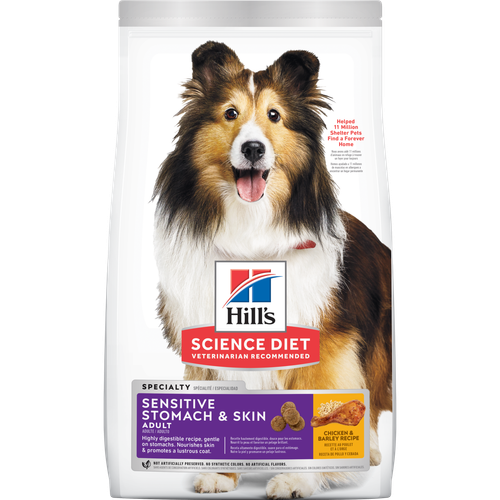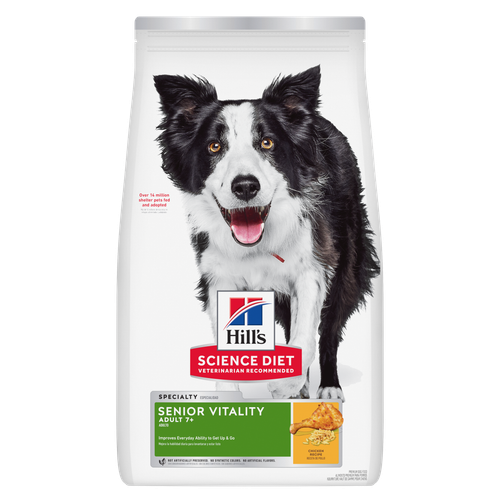
-
Find the right food for your petTake this quiz to see which food may be the best for your furry friend.Find the right food for your petTake this quiz to see which food may be the best for your furry friend.Health CategoryFeatured products
 Hill's Science Diet Adult Sensitive Stomach & Skin Chicken Recipe Dog Food
Hill's Science Diet Adult Sensitive Stomach & Skin Chicken Recipe Dog FoodHill's Science Diet Sensitive Stomach & Skin dry dog food is gentle on stomachs while nourishing skin & promoting a lustrous coat.
Shop Now Hill's Science Diet Adult Healthy Mobility Large Breed Chicken Meal, Barley & Brown Rice Recipe Dog Food
Hill's Science Diet Adult Healthy Mobility Large Breed Chicken Meal, Barley & Brown Rice Recipe Dog FoodAdvanced nutrition shown to support joint health and improve mobility
Shop Now Adult 7+ Senior Vitality Chicken Recipe Dog Food
Adult 7+ Senior Vitality Chicken Recipe Dog FoodImproves Everyday Ability to Get Up & Go
Shop NowFeatured products Adult Sensitive Stomach & Skin Pouch Variety 12 Pack Cat Food, Chicken & Beef, Salmon & Tuna
Adult Sensitive Stomach & Skin Pouch Variety 12 Pack Cat Food, Chicken & Beef, Salmon & TunaCarefully made, gourmet daily nutrition. Tasty chunks with Salmon & Tuna in a decadent gravy. Supports digestive health, nourishes skin and promotes a lustrous fur.
Shop Now Adult Oral Care Chicken & Brown Rice Recipe Cat Food
Adult Oral Care Chicken & Brown Rice Recipe Cat FoodClinically proven kibble technology to reduce plaque & tartar build-up
Shop Now Adult Perfect Digestion Chicken, Barley & Whole Oats Recipe Cat Food
Adult Perfect Digestion Chicken, Barley & Whole Oats Recipe Cat FoodHill's Science Diet's breakthrough nutrition supports ultimate digestive well-being & healthy microbiome
Shop Now -
DogCat
- Cat Tips & Articles
-
Health Category
- Weight
- Skin & Food Sensitivities
- Urinary
- Digestive
- Kidney
- Dental
- Serious Illness
-
Life Stage
- Kitten Nutrition
- Adult Nutrition
Featured articles Cat vs. Dog: Which Is the Best Pet for Me?
Cat vs. Dog: Which Is the Best Pet for Me?Learn about important differences between dogs and cats, such as cost & space considerations. These factors can help you decide which pet is best for you.
Read More Adopting a Pet: What You Need to Know
Adopting a Pet: What You Need to KnowLearn the basics of adopting a pet, including where to begin and common questions you should ask yourself when deciding which kind of pet is best for you.
Read More Fun Ideas for Kids and Pets This Summer
Fun Ideas for Kids and Pets This SummerOutdoor summer activities with your dog or cat can be fun for kids, too. Learn how they also teach kids responsibility & creates a bond with their pet.
Read More -


Changing dog food isn't something you should rush into, especially when bringing home a new dog. Seeing canines chow down on the contents of an overturned trash can you might be tempted to think they have iron stomachs. The reality, however, is that dogs have surprisingly sensitive tummies, and abrupt changes to their food can upset them. To help make a dog food transition go smoothly for your new housemate, follow these steps:
Start with What He Knows
Ask the shelter to send some food home with you. Ideally, they should provide you with enough for your dog's first week. If they can't, find out what they were feeding your dog before you adopted him and pick up a small bag before bringing him home.
Switch Food Gradually
A lot of pet shelters have budgetary constraints that keep them from feeding premium foods to their animals, so you might be anxious in changing dog food right away. And although your intentions are good, you should resist the urge. Abrupt changes to your dog's diet could result in gastrointestinal disturbances that lead to vomiting and/or diarrhea—and the last thing you want to do is condition him to associate his new home with discomfort.
How gradually should you switch? Most experts recommend taking between five to seven days, adding a little more of the new food and reducing the old each day. PetMD recommends the following feeding ratio:
- On day one, mix 20 percent of the new food with 80 percent of the old.
- On day two, mix 40 percent of the new food with 60 percent of the old.
- On day three, mix 60 percent of the new food with 40 percent of the old.
- On day four, mix 80 percent of the new food with 20 percent of the old.
- On day five, feed your dog 100 percent of his new food.
Watch and Learn
Keep an eye on your dog's reaction to the new food. In addition to signs of stomach upset, you should also keep an eye on your dog's stool. If it appears runny or abnormally soft, or if your dog shows other signs of an upset stomach, slow down this process and give him more time to adjust.


Tasty Tips
Identify When He's Not Ready
Your dog may not seem to tolerate the new food, no matter how slowly you go, and that's OK too. Slowly shift him back to the old food and start again with something else after giving his tummy a break. It could be that the new dog food contains ingredients to which your dog has an intolerance or allergy. If you continue to have trouble changing dog food, or if his stools contain blood or an unusual color, you should consult a veterinarian.
Keep Him Hydrated
Give your dog plenty of water, especially now, as he'll need to stay hydrated during the transition. If he stops drinking, however, or seems to be drinking an excessive amount, this might be a sign of a more complicated digestion issue with the new food. Again, see your vet to ensure he's taking to it healthily.
How to Change Dog Food Quickly
You might be in a situation where your new dog's previous food is unknown to you, and his old food simply isn't something you can get your hands on. In this case, consider introducing your dog to his new food slowly by feeding him small meals every few hours, keeping an eye out for signs of trouble in between meals. If necessary, choose an easily digestible formula to start off with. Once he's used to it, gradually switch him to your preferred brand or formula.
The potential stomach ache (and mess) should be enough of a reason to go slow when transitioning dog food, but above all, consider the numerous changes your new dog is already dealing with as he settles into his new life. Like people, dogs take comfort in the familiar. Being served the food he knows during his first few days with you will help him feel more at home in his new digs—which is just as good for his emotional health as it is for his digestion.


Jean Marie Bauhaus is a pet parent, pet blogger, and novelist from Tulsa, Oklahoma, where she usually writes under the supervision of a lapful of fur babies.
Related products

Fewer calories for less active dogs

Supports healthy joints, lean muscle, and beautiful coat for large breed dogs

Fewer calories for less active large breed dogs

Advanced nutrition shown to support joint health and improve mobility
Related articles

Though it may seem like your four-legged friend loves nothing more than to nap on the couch, dogs need regular exercise to stay healthy just like people do.

A little exercise can make a big difference. Not only will it enhance your pet’s health, but it will beef up your relationship as well.

Learn about choosing the right dog food to help ensure your mature older dog will receive the correct balance of nutrition.

Learn how to stop your dog from begging at the dinner table, and understand how it can help contribute to his health.

Put your dog on a diet without them knowing
Our low calorie formula helps you control your dog's weight. It's packed with high-quality protein for building lean muscles, and made with purposeful ingredients for a flavorful, nutritious meal. Clinically proven antioxidants, Vitamin C+E, help promote a healthy immune system.
Put your dog on a diet without them knowing
Our low calorie formula helps you control your dog's weight. It's packed with high-quality protein for building lean muscles, and made with purposeful ingredients for a flavorful, nutritious meal. Clinically proven antioxidants, Vitamin C+E, help promote a healthy immune system.

